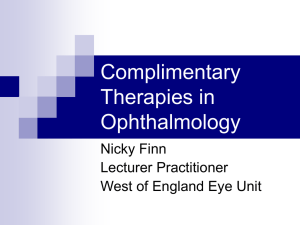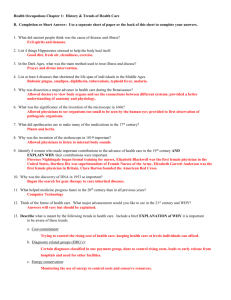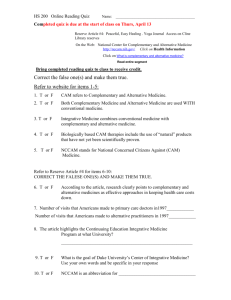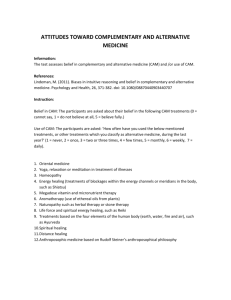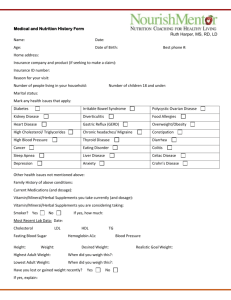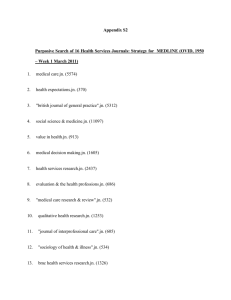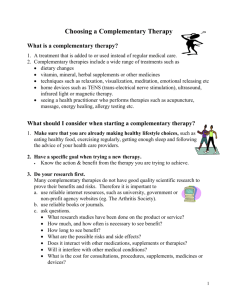CAM lecture - Find Your Stride
advertisement
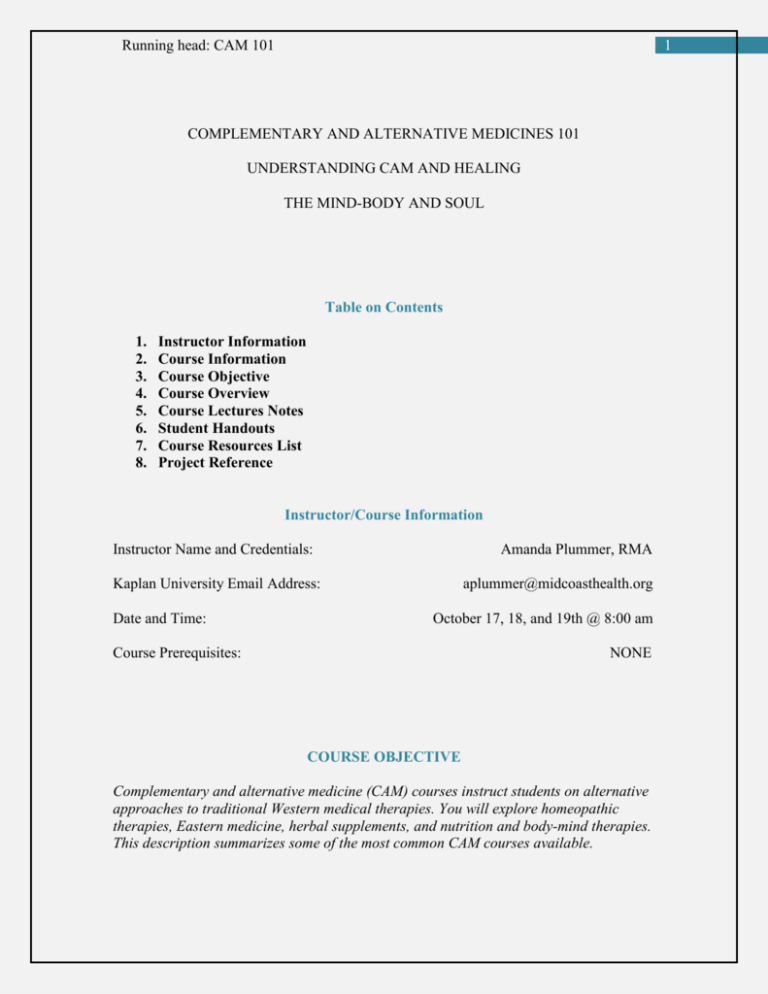
1 Running head: CAM 101 COMPLEMENTARY AND ALTERNATIVE MEDICINES 101 UNDERSTANDING CAM AND HEALING THE MIND-BODY AND SOUL Table on Contents 1. 2. 3. 4. 5. 6. 7. 8. Instructor Information Course Information Course Objective Course Overview Course Lectures Notes Student Handouts Course Resources List Project Reference Instructor/Course Information Instructor Name and Credentials: Amanda Plummer, RMA Kaplan University Email Address: Date and Time: aplummer@midcoasthealth.org October 17, 18, and 19th @ 8:00 am Course Prerequisites: NONE COURSE OBJECTIVE Complementary and alternative medicine (CAM) courses instruct students on alternative approaches to traditional Western medical therapies. You will explore homeopathic therapies, Eastern medicine, herbal supplements, and nutrition and body-mind therapies. This description summarizes some of the most common CAM courses available. Running head: CAM 101 Course Objectives: At the end of this lecture individuals will be able to: 1. Knowledge of the basic theory and practice of complementary and alternative therapies used commonly by consumers. 2. Awareness of the scientific knowledge and data about the efficacy, mechanism of action, and safety of CAM therapies. 3. Knowledge and confidence to evaluate and discuss CAM therapies with patients and providers in a responsible and cooperative manner. 4. CAM Therapies and healing systems which patients most commonly seek. 5. Principles of evidence-based medicine, their application, and limitation in the study of complementary and alternative medicine. Course Outline: Day 1: BASICS Introduction Instructor Individual The use of Complementary and Alternative Medicine (CAM) What is CAM? What are complementary and alternative medicine therapies? Alternative Medical Systems* Mind-Body Interventions* Day 2: BASICS CONTUIED What are complementary and alternative medicine therapies (cont.) Biologically Based Therapies* Manipulative and Body-Based Methods* Energy Therapies* Relaxation Techniques Deep Breathing ® Mediation ® Day 3: BASICS CONTUIED Diet and Nutrition* Supplements Dietary Supplementation® Herbal medicine® *PowerPoint presentation, ®Handout 2 Running head: CAM 101 Lecture Notes / Day 1: What is CAM? Complementary and alternative medicine (CAM) refers to healing approaches and therapies that are not based on principles of mainstream, conventional medicine. Complementary medicine refers to unconventional practices used with mainstream medicine. Alternative medicine refers to unconventional practices used instead of mainstream medicine. Integrative medicine is health care that uses all appropriate therapeutic approaches conventional and alternative within a framework that focuses on the therapeutic relationship and the whole person. CAM has been widely used in the US for decades. Almost 40% of adults use some form of CAM, most often to treat pain or anxiety or to modify cholesterol levels. Use is also common among patients with chronic pain, cancer, hepatitis C, or other intractable conditions. The most frequently used therapies include medicinal herbs (see Dietary Supplements) and other plant-derived supplements (botanicals), mind-body practices, and massage therapy. (Overview of Complementary and Alternative Medicine, 2010) Some CAM therapies are now offered in hospitals and are sometimes reimbursed by insurance companies. Some traditional medical schools, including 45 North American medical schools in the Consortium of Academic Health Centers for Integrative Medicine, provide education about CAM and integrative medicine. (Overview of Complementary and Alternative Medicine, 2010) What are complementary and alternative medicine therapies? Five categories of alternative medicine are generally recognized: 1. 2. 3. 4. 5. Alternative whole medical systems Mind-body medicine Biologically based practices Manipulative and body-based practices Energy medicine Alternative medical systems are complete systems with explanation of disease, diagnosis, and therapy. Ayurveda, the traditional medical system of India, originated > 4000 yr. ago. It is based on the theory that disease results from an imbalance of the body's life force (prank). The balance of prana is determined by equilibrium of the 3 bodily qualities (doshas): vata, pitta, and kapha. Most people have a dominant dosha; the specific balance is unique to each person. 3 Running head: CAM 101 Uses: After determining the balance of doshas, practitioners design a treatment specifically tailored to each patient. Ayurveda uses diet, herbs, massage, meditation, yoga, and therapeutic detoxification (panchakarma)—typically with enemas, oil massages, or nasal lavage—to restore balance within the body and with nature. Homeopathy, Developed in Germany in the late 1700s, homeopathy is based on the principle that like cures like. A substance that, when given in large doses, causes a certain set of symptoms is believed to cure the same symptoms when it is given in minute doses. The minute dose is thought to stimulate the body's healing mechanisms. Treatments are based on the patient's unique characteristics, including personality and lifestyle, as well as symptoms and general health. (Overview of Complementary and Alternative Medicine, 2010) Remedies used in homeopathy are derived from naturally occurring substances, such as plant extracts and minerals. Extremely low concentrations are prepared in a specific way. The more dilute the homeopathic remedy, the stronger it is considered to be. Uses: Homeopathy has been used to treat various disorders, such as allergies, rhinitis, digestive problems, musculoskeletal pain, and vertigo. The effect of homeopathic solutions on joint pain and tenderness and quality of life in fibromyalgia is being studied. Traditional Chinese Medicine, Originating > 2000 yr ago, traditional Chinese medicine is based on the theory that disease results from improper flow of the life force (qi). The movement of qi is restored by balancing the opposing forces of yin and yang, which manifest in the body as heat and cold, external and internal, and deficiency and excess. Various practices (eg, acupuncture, diet, massage, medicinal herbs, meditative exercise called qi gong) are used to preserve and restore qi and thus health. (Overview of Complementary and Alternative Medicine, 2010) Mind-body medicine is based on the theory that mental and emotional factors influence physical health through a system of neuronal, hormonal, and immunologic connections throughout the body. Behavioral, psychologic, social, and spiritual techniques are used to preserve health and to prevent or cure disease Because scientific evidence supporting the benefits of mind-body medicine is abundant, many of these approaches are now considered mainstream, although they remain underused. Techniques such as biofeedback, guided imagery, hypnotherapy, meditation, and relaxation are used in the treatment of chronic pain, coronary artery disease, headaches, insomnia, and incontinence and as aids during childbirth. These techniques are also used to help patients cope with disease-related and treatment-related symptoms of cancer and to prepare patients for surgery. Efficacy of mind-body medicine in patients with asthma, hypertension, or tinnitus is not as clear. (Overview of Complementary and Alternative Medicine, 2010) Biofeedback, For this technique, electronic devices are used to provide information to patients about biologic functions (eg, heart rate, BP, muscle activity, skin temperature, skin resistance, brain surface electrical activity). 4 Running head: CAM 101 Uses: With the help of a therapist or with training, patients can then use information from biofeedback to modify the function or to relax, thereby lessening the effects of conditions such as pain, stress, insomnia, and headaches. Biofeedback is also used in patients with fecal or urinary incontinence, chronic abdominal pain, tinnitus, Raynaud's syndrome, or attention or memory disorders (eg, attention-deficit/hyperactivity disorder, traumatic brain injury). Generally, biofeedback does not seem to be useful in asthma; a possible exception is heart rate variability biofeedback, which may help reduce asthma symptoms and drug use and improve pulmonary function. (Overview of Complementary and Alternative Medicine, 2010) Guided imagery, Mental images, self-directed or guided by a practitioner, are used to help patients relax (eg, before a procedure) and to promote wellness and healing (to try to effect physical changes—eg, by mobilizing the immune system). The images can involve any of the senses. Uses: Imagery used with relaxation techniques (muscle relaxation and deep breathing) may help reduce pain and improve quality of life in patients with cancer. Imagery has also been used in patients with psychologic trauma. (Overview of Complementary and Alternative Medicine, 2010) Hypnotherapy is derived from western psychotherapeutic practice. Patients are put into an advanced state of relaxation. They become absorbed in the images presented by the hypnotherapist and are relatively distracted from but not unconscious of their surroundings and the experiences they are undergoing. Some patients learn to hypnotize themselves. (Overview of Complementary and Alternative Medicine, 2010) Uses: Hypnotherapy is used to treat pain syndromes, phobias, and conversion disorders and has been used with some success to manage smoking cessation and weight loss. It can reduce pain and anxiety during medical procedures in adults and children. It may be useful in irritable bowel syndrome, headaches, asthma, and some skin disorders (eg, warts, psoriasis). It may help lower BP. Hypnotherapy helps control nausea and vomiting (particularly anticipatory) related to chemotherapy and is useful in palliative cancer care. (Overview of Complementary and Alternative Medicine, 2010) In meditation, patients regulate their attention or systematically focus on particular aspects of inner or outer experience. The most highly studied forms of meditation are transcendental meditation (TM) and mindfulness meditation. Uses: Meditation has been used to relieve anxiety, pain, depression, stress, insomnia, and symptoms of chronic disorders such as cancer or cardiovascular disorders. It is also used to promote wellness. Relaxation techniques are practices specifically designed to relieve tension and strain. The specific technique may be aimed at: Reducing activity of the sympathetic nervous system Lowering BP 5 Running head: CAM 101 Easing muscle tension Slowing metabolic processes Altering brain wave activity Relaxation techniques may be used with other techniques, such as meditation, guided imagery, or hypnotherapy. Lecture Notes/Day 2: What is CAM? Biologically based practices use naturally occurring substances and include biologic therapies (eg, shark cartilage to treat cancer, glucosamine to treat osteoarthritis), diet therapies, herbalism (see Dietary Supplements), orthomolecular medicine, and chelation therapy. Diet therapy uses specialized dietary regimens (eg, Gerson therapy, macrobiotic diets, Pritikin diet) to treat or prevent a specific disorder (eg, cancer, cardiovascular disorders) or generally promote wellness. Some diets (eg, Mediterranean diet) are widely accepted and encouraged in traditional western medicine. The Ornish diet, a very low-fat vegetarian diet, can help reverse arterial blockages that cause coronary artery disease and may help prevent or slow the progression of prostate and other cancers. Some people following a macrobiotic diet have reported cancer remission, but a well-controlled clinical study has not been conducted. Because it usually takes months or years for benefits to be realized, diet therapy is more likely to be effective if started early. (Overview of Complementary and Alternative Medicine, 2010) Orthomolecular medicine, also called nutritional medicine, aims to provide the body with optimal amounts of substances that naturally occur in the body. Nutrition is the focus in diagnosis and treatment. This therapy differs from diet therapy because it uses supradietary doses of individual micronutrients. High doses of vitamins, minerals, enzymes, hormones (eg, melatonin), amino acids, or various combinations may be used. Practitioners believe that people's nutritional needs far exceed the recommended daily allowances and that nutritional therapy must be individualized based on each patient's medical profile. High doses of micronutrients are also used as biologic response modifiers in an attempt to modulate inflammation and other disease processes. Doses may be administered orally or, far less often, intravenously. (Overview of Complementary and Alternative Medicine, 2010) Evidence and uses: Treatment claims include benefit for a wide range of disorders (eg, cancer, cardiovascular disease, chronic fatigue, chronic pain, autism, psychiatric disorders). These treatments are widely used, and many patients report clinical improvement. In chelation therapy, a drug is used to bind with and remove hypothesized excess or toxic amounts of a metal or mineral (eg, lead, copper, iron, calcium) from the 6 Running head: CAM 101 bloodstream. In conventional medicine, chelation therapy is a widely accepted way to treat lead and other heavy metal poisoning (see Treatment). Chelation therapy with EDTA (ethylene diamine tetraacetic acid) has also been suggested as a way to remove calcium and thus treat atherosclerosis; whether this use is safe and effective has not been proved but is under study. (Overview of Complementary and Alternative Medicine, 2010) Manipulative and body-based practices include chiropractic, massage therapy, postural reeducation, reflexology, and structural integration. In chiropractic, the relationship between the structure of the spine and function of the nervous system is thought to be the key to maintaining or restoring health. The main method for restoring this relationship is spinal manipulation. Chiropractors may also provide physical therapies (eg, heat and cold, electrical stimulation, rehabilitation strategies), massage, or acupressure and may recommend exercises or lifestyle changes. Uses: Chiropractic provides short-term relief of low back pain, but continuing adjustments may not provide additional benefit. In massage therapy, body tissues are manipulated to promote wellness and reduce pain and stress. The therapeutic value of massage for many musculoskeletal symptoms and stress is widely accepted. Massage has been shown to help relieve the following: Muscle soreness Pain due to back injuries Fibromyalgia Anxiety, fatigue, pain, nausea, and vomiting in cancer patients Massage therapy is reported to be effective in treating low birth weight infants, preventing injury to the mother's genitals during childbirth, relieving chronic constipation, and controlling asthma. Energy medicine intends to manipulate subtle energy fields (also called biofields) thought to exist in and around the body. All energy therapies are based on the belief that a universal life force or subtle energy resides in and around the body. Qi gong, which is used in traditional Chinese medicine, is an energy therapy. Acupuncture, a therapy within traditional Chinese medicine, is one of the most widely accepted alternative therapies in the western world. Specific points on the body are stimulated, usually by inserting thin needles into the skin and underlying tissues. Stimulating these specific points is believed to unblock the flow of qi along energy pathways (meridians) and thus restore balance; > 350 defined points are located along the meridians. The procedure is generally not painful but may cause a tingling sensation. Sometimes stimulation is increased by twisting or warming the needle. Acupuncture points may also be stimulated by pressure (called acupressure), lasers, ultrasound, or a very low voltage electrical current (called electroacupuncture) applied to the needle. (Overview of Complementary and Alternative Medicine, 2010) 7 Running head: CAM 101 Therapeutic touch, sometimes referred to as laying on of hands, uses the therapist's healing energy to identify and repair imbalances in a patient's biofield. Usually, practitioners do not touch the patient; instead, they move their hands back and forth over the patient. Therapeutic touch has been used to lessen anxiety and improve the sense of well-being in patients with cancer, but these effects have not been rigorously studied. In the US, nurses have introduced therapeutic touch into ICUs and other hospital settings. Reiki: Reiki, which originated in Japan, is a similar technique; in Reiki, practitioners channel energy through their hands and transfer it into the patient's body to promote healing. Practitioners are thought to have special healing powers, which are required for these treatments. (Overview of Complementary and Alternative Medicine, 2010) Relaxation Techniques Method 1 of 3: Learning Basic Belly Breathing 1.Take a slow, deep breath in. Let the air completely fill your lungs, and resist the urge to exhale quickly before you've fully inhaled. It definitely takes some practice, since most of us are in the habit of taking quicker, shallower breaths instead of long, deep ones. Focus on breathing in as much as you can through your nose, which has tiny hairs that filter out dust and toxins so they can't reach your lungs. •As we go about our days, we often breathe in a quick, shallow way without being conscious we are doing so. Daily stresses distract us from being mindful of the way we are breathing. Deep breathing will help you be more mindful of your body. Feel the air enter your lungs and fill them up. When you're concentrating on taking a deep breath, your worries are pushed aside for the time being. 2. Let your stomach expand. As you draw in a deep breath, let your stomach expand by an inch or two. The air should travel all the way to your diaphragm, causing your belly to round out as it fills. If you watch a baby sleep, you'll see that babies naturally bellybreathe; their stomachs, not their chests, rise and fall with each breath.[2] As adults, we get conditioned to take shallow breaths instead of belly breaths. We tend to hold in our emotions and suck in our stomachs, tensing up rather than relaxing when we breathe. When you learn how to breathe properly, the tension goes away. •Lay down, stand, or sit upright as you breathe. It's more difficult to draw in a full breath if you're in a slouched position. •Place a hand on your belly, and the other on your chest, as you inhale. You can tell you're breathing deeply and properly if the hand on your belly rises out further than the one on your chest as you inhale 8 9 Running head: CAM 101 3. Exhale fully. Let out your breath through either your mouth or your nose. As you breathe out, pull in your belly toward your spine and exhale all of the breath in your lungs. After you exhale, take in another deep breath through your nose and continue breathing deeply. Try to exhale for twice as long as you inhale, and fully expel the air. 4.Try breathing deeply five times in a row. This immediately calms you down by slowing your heart rate and blood pressure, as well as distracting your mind from stressful thoughts. Get in a comfortable position and practice deep breathing correctly 5 times in a row. •Remember that your stomach should expand an inch or so from your body, further than your chest expands. •When you get the hang of deep breathing, try doing it 10 or 20 times in a row. Notice how your body and mind begin to feel as you get flooded with oxygen (How to breath Deeply, n.d.) How To Mediate In 6 Easy Steps Step 1: Before you get started Before you start, you need to take care of a few practicalities. When are you going to do it each day? Where can you sit undisturbed? How will you even remember to do it? The first step is committing to a regular, daily practice. Taking 10 minutes out each day shouldn’t be difficult, but it’s easy to get caught up in everything that’s going on. Try to make it a regular part of your schedule. Create a space to sit at the same time each day. Mornings seem to work best for most people, but find a time that works for you. Where you do it doesn’t matter, just as long as you’re unlikely to be interrupted. Step 2: Get settled Find a quiet space where you can relax. Sit comfortably in a chair with your hands resting in your lap or on your knees. Keep you’re back straight sitting at the front of the seat might help. Your neck should be relaxed, with your chin slightly tucked in. Whether you’re using a timer or following an MP3, commit to practicing for the full time you’ve set aside, whether you find the session easy or difficult. Step 3: Breathe deeply Defocus your eyes, gazing softly into the middle distance. Take five deep, audible breaths, breathing in through the nose and out through the mouth. On the last exhalation, allow your eyes to close Running head: CAM 101 Step 4: Check in Take a few moments to settle into your body. Gently observe your posture, and notice the sensations where your body touches the chair and your feet meet the ground. Feel the weight of your arms and hands resting on your legs. Acknowledge your senses: notice anything you can smell, hear or taste and sensations of heat, cold or wind Step 5: Observe the breath Bring your attention to your breathing. Don’t make any effort to change it, just observe the rising and falling sensation that it creates in your body. Notice where these sensations occur – be it your belly, your chest, your shoulders, or anywhere else. For a few moments, focus on the quality of each breath, noting whether it’s deep or shallow, long or short, fast, or slow. Begin silently counting the breaths: 1 as you inhale, 2 as you exhale, 3 on the next inhalation, and so on, up to 10. Then start again at 1. Step 6: Allow your mind to be free Spend 20-30 seconds just sitting. You might find yourself inundated with thoughts and plans, or feel calm and focused. Whatever happens is completely fine. Enjoy the rare chance to let your mind simply be. Step 9: Prepare to finish Become aware once more of the physical feelings: of the chair beneath you, where your feet make contact with the floor, your arms, and your hands resting in your lap. Notice anything you can hear, smell, taste, or feel. When you’re ready, slowly open your eyes. (How to Mediate in 6 Easy Steps, n.d.) Lecture Notes/Day 3: Diet and Nutrition Healthy eating is not about strict dietary limitations, staying unrealistically thin, or depriving yourself of the foods you love. Rather, it’s about feeling great, having more energy, and stabilizing your mood. If you feel overwhelmed by all the conflicting nutrition and diet advice out there, you’re not alone. It seems that for every expert who tells you a certain food is good for you, you’ll find another saying exactly the opposite. 10 Running head: CAM 101 But by using these simple tips, you can cut through the confusion and learn how to create a tasty, varied, and healthy diet. (Healthy Eating, n.d.) People often think of healthy eating as an all or nothing proposition, but a key foundation for any healthy diet is moderation. But what is moderation? In essence, it means eating only as much food as your body needs. You should feel satisfied at the end of a meal, but not stuffed. Moderation is also about balance. Despite what certain fad diets would have you believe, we all need a balance of carbohydrates, protein, fat, fiber, vitamins, and minerals to sustain a healthy body. According to the Dietary Guidelines for Americans 2010, men ages 19 and older reported consuming an average of 2,640 calories and women reported consuming an average of 1,785 calories each day based on national survey, self-reported data. However, the same source reports that studies suggest actual calorie consumption among men and women in the U.S. may be higher than reports show due to underreporting of energy intake, especially in overweight and obese populations. (Erin Coleman, n.d.) The amount of calories men require each day varies based on their age and activity level. Calorie recommendations decrease with age. The U.S. Department of Agriculture recommends men consume 2,000 to 2,600 calories if they’re sedentary, 2,200 to 2,800 calories if they’re moderately active and 2,400 to 3,000 calories per day if they are active. (Erin Coleman, n.d.) Because women generally have a smaller frame and less lean body mass than men, they usually require fewer calories. The U.S. Department of Agriculture recommends women consume 1,600 to 2,000 calories if they are sedentary, 1,800 to 2,200 calories if they’re moderately active and 2,000 to 2,400 calories per day if they are active. (Erin Coleman, n.d.) Dietary Supplements Dietary supplements are vitamins, minerals, herbs, and many other products. They can come as pills, capsules, powders, drinks, and energy bars. Supplements do not have to go through the testing that drugs do. Some supplements can play an important role in health. For example, calcium and vitamin D are important for keeping bones strong. Pregnant women can take the vitamin folic acid to prevent certain birth defects in their babies. Some Common Dietary Supplements: Acidophilus Echinacea Fiber Ginger Glucosamine and/or Chondroitin Sulphate Minerals 11 Running head: CAM 101 Omega-3 Fatty Acids Saw Palmetto Vitamins Let your health care providers (including doctors, pharmacists, and dietitians) know which dietary supplements you're taking so that you can discuss what's best for your overall health. Your health care provider can help you determine which supplements, if any, might be valuable for you. Dietary supplements are products intended to supplement the diet. They are not drugs and, therefore, are not intended to treat, diagnose, mitigate, prevent, or cure diseases. The FDA is the federal agency that oversees both dietary supplements and medicines. (Dietary Supplements: What You Need to Know, 2011) Herbal Supplementation Herbal supplements, sometimes called botanicals, aren't new. Plants have been used for medicinal purposes for thousands of years. However, herbal supplements haven't been subjected to the same scientific scrutiny and aren't as strictly regulated as medications. For example, makers of herbal supplements don't have to get approval from the Food and Drug Administration (FDA) before putting their products on the market. (Dietary Supplements: What You Need to Know, 2011) Yet some herbal supplements including products labeled as "natural" have drug-like effects that can be dangerous. So it's important to do your homework and investigate potential benefits and side effects of herbal supplements before you buy. And be sure to talk with your doctor, especially if you take medications, have chronic health problems, or are pregnant or breast-feeding. (Dietary Supplements: What You Need to Know, 2011) A few Herbal Supplements: Ginkgo Biloa Turmeric Garlic Cinnamon Red Yeast Rice Again, Let your health care providers (including doctors, pharmacists, and dietitians) know which dietary supplements you're taking so that you can discuss what's best for your overall health. Your health care provider can help you determine which supplements, if any, might be valuable for you. 12 Running head: CAM 101 Reference: Dietary Supplements: What You Need to Know. (2011, 6 11). Retrieved 9 29, 2014, from National Institutes of Health: http://ods.od.nih.gov/HealthInformation/DS_WhatYouNeedToKnow.aspx Erin Coleman, R. L. (n.d.). The Average Calorie Intake by a Human Per Day Versus the Recommendation. Retrieved 9 29, 2014, from SFGAte: http://healthyeating.sfgate.com/average-calorie-intake-human-per-day-versusrecommendation-1867.html Healthy Eating. (n.d.). Retrieved 9 29, 2014, from The Help Guide: http://www.helpguide.org/life/healthy_eating_diet.htm How to breath Deeply. (n.d.). Retrieved 9 29, 2014, from WedMD: http://www.webmd.com/balance/stress-management/stress-managementbreathing-exercises-for-relaxation How to Mediate in 6 Easy Steps. (n.d.). Retrieved 9 29, 2014, from The Guardian: http://www.theguardian.com/lifeandstyle/gallery/2011/jan/22/how-to-meditateten-steps-headspace Overview of Complementary and Alternative Medicine. (2010, 2). Retrieved 9 29, 2014, from The Merck Mannual: http://www.merckmanuals.com/professional/special_subjects/complementary_and _alternative_medicine/overview_of_complementary_and_alternative_medicine.ht ml 13
